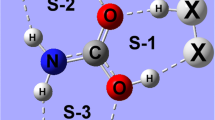Abstract
Ab initio quantum chemistry methods were used to analyze the noncovalent interactions between HOCl and SHX (X = F, CN, NC, Cl, Br, NO2, CCH, CH3, H). Three energetic minimal configurations were characterized for each case, where the S center acts as a Lewis acid interacting with O to form a chalcogen bond, as well as a Lewis base interacting with Cl or H of HOCl to form halogen bond and hydrogen bond, respectively. An electronegative substituent such as F, CN, NC and NO2 tends to form a stronger chalcogen bond, while an electropositive substituent such as CCH, CH3 and H is inclined to form a more stable H-bonded complex. The chalcogen-bonded, halogen-bonded and H-bonded complexes are stabilized by charge transfers from Lp(O) to σ*(SX), from Lp(S) to σ*(ClO), and from Lp(S) to σ*(HO), respectively. As a result, the SHX unit becomes positively charged in halogen-bonded and hydrogen-bonded complexes but negatively charged in chalcogen-bonded complexes. Theory of atoms in molecules, natural bond orbital analysis, molecular electrostatic potential and localized molecular orbital energy decomposition analysis were applied to investigate these noncovalent bonds.






Similar content being viewed by others
References
Scheiner S (1997) Hydrogen bonding. Oxford University Press, New York
Jeffrey GA, Saenger W (1991) Hydrogen bonding in biological structures. Springer, Berlin
Desiraju GR, Steiner T (1999) The weak hydrogen bond in structural chemistry and biology. Oxford University Press, New York
Grabowski SJ (2006) Hydrogen bonding—new insights. Springer, Dordrecht
Thakur TS, Kirchner MT, Bläser D, Boese R, Desiraju GR (2011) Phys Chem Chem Phys 13:14076–14091
Peris E, Lee JCJ, Rambo J, Eisenstein O, Crabtree RH (1995) J Am Chem Soc 117:3485
Lipkowski P, Grabowski SJ, Leszczynski J (2006) J Phys Chem A 110:10296
Pauling L (1960) The nature of the chemical bond, 3rd edn. Ithaca, Cornell University Press
Grabowski SJ, Sokalski WA, Leszczynski (2006) J Chem Phys Lett 422:334
Zordan F, Brammer L, Sherwood P (2005) J Am Chem Soc 127:5979
Politzer P, Murray JS, Concha MC (2007) J Mol Model 13:643–650
Politzer P, Lane P, Concha MC, Ma YG, Murray JS (2007) J Mol Model 13:305
Clark T, Hennemann M, Murray JS, Politzer P (2007) J Mol Model 13:291
Politzer P, Murray JS (2011) Cryst Eng Comm 13:6593–6596
Metrangolo P, Murray JS, Pilati T, Politzer P et al (2011) Cryst Growth Des 11:4238–4246
Bernard-Houplain MC, Sandorfy C (1973) Can J Chem 51:3640–3647
Metrangolo P, Neukirch H, Pilati T, Resnati G (2005) Acc Chem Res 38:386
Riley KE, Hobza P (2008) J Chem Theory Comput 4:232
Brinck T, Murray JS, Politzer P (1992) Int J Quantum Chem 44:57
Murray JS, Lane P, Clark T, Politzer P (2007) J Mol Model 13:1033–1038
Murray JS, Lane P, Politzer P (2007) Int J Quantum Chem 107:2286–2292
Murray J, Lane P, Politzer P (2009) J Mol Model 15:723
Mohajeri A, Pakirai AH, Bagheri N (2009) Chem Phys Lett 467:393–397
Scheiner S (2011) J Phys Chem A 115:11202
Politzer P, Riley KE, Bulat FA, Murray JS (2012) Comput Theor Chem 998:2–9
Scheiner S (2013) Acc Chem Res 46:280–288
Politzer P, Murray J, Clark T (2013) Phys Chem Chem Phys 15:11178–11189
Politzer P, Murray JS, Lane P, Clark T (2014) Top Curr Chem. doi:10.1007/128_2014_568
Rosenfield RE, Parthasarathy JR, Dunitz JD (1977) J Am Chem Soc 99:4860–4862
Guru Row TN, Parthasarathy R (1981) J Am Chem Soc 103:477–479
Alikhani E, Fuster F, Madebene B, Grabowski SJ (2014) Phys Chem Chem Phys 16:2430–2442
Alabugin IV, Manoharan M, Peabody S, Weinhold F (2003) J Am Chem Soc 125:59–73
Weinhold F, Landis C (2005) Valency and bonding: a natural bond orbital donor acceptor perspective. Cambridge University Press, Cambridge
Li AY (2007) J Chem Phys 126:154102
Frisch MJ, Trucks GW, Schlegel HB, Scuseria GE, Robb MA et al (2009) Gaussian 09. Gaussian Inc, Wallingford
Boys SF, Bernardi F (1970) Mol Phys 19:553–566
Bader RFW (1991) Chem Rev 91:893–928
Bader RFW (1990) Atoms in molecules, a quantum theory. Oxford University Press, Oxford
Popelier PLA (2000) Atoms in molecules. An introduction. Prentice Hall, Harlow
Matta CF, Boyd RJ (2007) The quantum theory of atoms in molecules: from solid state to DNA and drug design. Wiley-VCH, Einham
Keith TA (2011) AIMAll, version 11.08.23. TK Gristmill Software, Overland Park
Reed AE, Curtiss LA, Weinhold F (1988) Chem Rev 88:899–926
Glendening ED, Badenhoop JK, Reed AE, Carpenter JE, Bohmann JA, Morales CM, Weinhold F (2004) NBO 5.G. University of Wisconsin, Madison
Su P, Li H (2009) J Chem Phys 131:014102
Schmidt M, Baldridge W, Boatz KK, Elbert JA, Gordon ST, Jensen MS, Koseki JH, Matsunaga S, Nguyen N, Sus KA et al (1993) J Comput Chem 14:1347–1363
Szawomir J, Grabowski J (2011) J Phys Chem A 115:12340–12347
Bent HA (1961) Chem Rev 61:275
Sanchez-Sanz G, Trujillo C, Alkorta I, Elguero J (2012) Chem Phys Chem 13:496–503
Weinhold F, Landis C (2005) Valency and bonding. Cambridge University Press, Cambridge
Author information
Authors and Affiliations
Corresponding author
Rights and permissions
About this article
Cite this article
Fang, Y., Li, A.Y. & Ma, F.Y. A comparative study of the chalcogen bond, halogen bond and hydrogen bond S⋯O/Cl/H formed between SHX and HOCl. J Mol Model 21, 61 (2015). https://doi.org/10.1007/s00894-015-2612-6
Received:
Accepted:
Published:
DOI: https://doi.org/10.1007/s00894-015-2612-6




